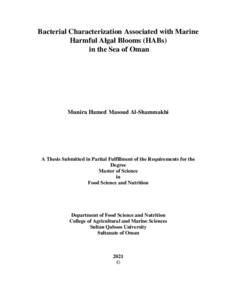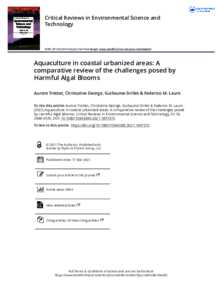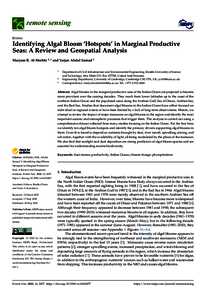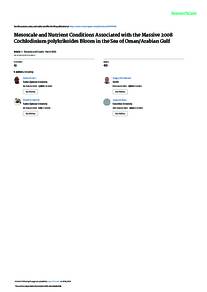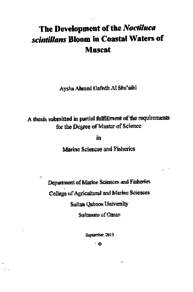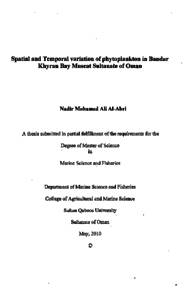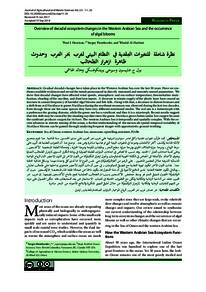Document
Bacterial characterization associated with marine harmful algal Blooms (HABs) in the Sea of Oman.
Identifier
Al-Shammakhiyah, Munira Hamed Masoud (2021). Bacterial characterization associated with marine harmful algal Blooms (HABs) in the Sea of Oman (Master thesis, Sultan Qaboos University, Muscat, Oman).
Publisher
Sultan Qaboos University.
Gregorian
2021
Language
English
English abstract
The Sea of Oman is exposed to the continuous incidences of harmful algal blooms (HABs)
known locally as red tide, which is mainly caused by a dinoflagellate called Noctiluca
scintillans. This phenomenon changes seawater microbial, chemical and physical
characteristics. The chemical and physical aspects of these changes have been well
documented. However, microbial community structure of seawater associated with HABs
and its impact on seafood safety and quality and the influences of environmental factors on
this composition are not fully understood. Therefore, this study aimed to examine the
composition of bacterial flora in HABs associated seawater in the Sea of Oman with
special attention to the composition and biodiversity of spoilage bacteria such as H2Sproducing bacteria and pathogenic bacteria namely Vibrio spp. A total of 9 sampling
occasions were conducted from January 2019 to September 2019 at Marina Bandar AlRawdha station. In each sampling occasion, 5 samples of one liter each were collected at
depth of 5 meter. Temperature, salinity, dissolved oxygen, pH and chlorophyll a were
measured simultaneously at sampling site. Ammonia (NH3), nitrate (NO3) and phosphorus
(P) were determined later. There were significant changes in seawater temperatures and
salinity during study period (p <0.001) and (p <0.05), respectively. In addition, a significant
variation was observed between NH3 and bloom progression (p < 0.05).
Total bacteria, Vibrio spp., H2S- producing bacteria and Enterobacteriaceae were
enumerated on 2% NaCl tryptone soya agar, thiosulfate citrate bile salts sucrose, iron agar
and violet red bile glucose agar, respectively. Bacteria were identified by MALDI-Biotyper
and 16S rRNA gene sequencing. Temperature, salinity, dissolved oxygen, pH and
chlorophyll a ranged from 23.74 - 31.35°C, 36.14 -36.48 ppt, 4.32 - 11.3 ppm, 8.12 - 8.60
and 0.53 - 5.42 mg/m3
respectively, while, NH3, NO3 and P ranged from 0.04 - 0.22 mg/l,
vi
1.3 - 3.5 mg/l and 0.01 - 0.05 mg/l. Total bacteria , Vibrio spp. and H2S- producing
bacterial counts ranged from log 2.21 - 3.13, 1.07 - 9.09 and < 1 CFU/ ml respectively,
whereas, Enterobacteriaceae were not detected during the 38-week Noctiluca scintillans
bloom cycle. Physical and chemical factors showed a positive correlation between Vibrio
spp. and temperature (r = 0.65) (p <0.001), dissolved oxygen (r = 0.41), pH (r = 0.86) (p
<0.001), NH3 (r = 0.39) and NO3 (r = 0.78) (p <0.001) while a negative correlation was
reported with salinity (r = -0.71), Chl a (r = -0.13) and P (r = -0.21). High diversity in the
Gammaproteobacterial community was found. For instance, the phylum Proteobacteria
class Gammaproteobacteria (66.22%) dominated the communities across N. scintillans
bloom cycle. The main species of Gammaproteobacteria identified during the experimental
period were Vibrio spp. (44.59%), Photobacterium sp. (16.22%) and Halomonas sp.
(4.05%). Among these vibrios, Vibrio alginolyticus (12 isolates) and Vibrio
parahaemolyticus (11 isolates) were mostly abundant after N. scintillans decayed stage.
This study showed a high bacterial diversity associated with Noctiluca scintillans bloom
with abundance of Vibrio spp. which were enhanced by different chemical and physical
factors. The abundance of Vibrio spp. in the current study could be a risk factor to the
safety of seawater and seafoods caught in the bloom zone, however, further studies are
needed to evaluate the pathogenicity of Vibrio spp.
Member of
Resource URL
Category
Theses and Dissertations

